Birzai/Birzh Memorial project
Below is the link to an article written about the project in Birzai Lithuania in which Glenda and I were involved with.
It will be published this week in the new South African online magazine Jewish Affairs.
We wish you a happy New Year and well over the Fast
Regards
Abel and Glenda Levitt Tuesday, September 17, 2019
THE BIRZAI/BIRZH MEMORIAL PROJECT, LITHUANIA
Veronica Belling, with Glenda Levitt
04 September 2019 https://www.sajbd.org/media/the-birzai-birzh-memorial-project-lithuania
Dr Veronica Belling is the author of Bibliography of South African Jewry (1997), Yiddish Theatre in South Africa (2008), and the translator of Leibl Feldman's The Jews of Johannesburg (2007) and Yakov Azriel Davidson: His Writings in the Yiddish Newspaper, Der Afrikaner, 1911-1913 (2009). This article was prepared in consultation with and the input of Glenda Levitt, who with her husband Abel headed up the Birzai/Birzh Memorial Project.
On 16 June 2019, a new memorial for the victims of the massacre that took place near Birzai, Lithuania, was unveiled. Located in the Astravas Grove in the Pakamponys forest four kilometres outside the town, it is the third memorial in Lithuania to bear the names of the victims at the massacre site. It is also the second memorial wall of names that Abel and Glenda Levitt, former South Africans living in Kfar Saba, Israel, were instrumental in creating. The previous memorial, in the Kausenai forest where the Jews of Plunge, including Abel Levitt’s family, were murdered, was unveiled in July 2011. The Levitts were also indirectly instrumental in inspiring the creation of a second name memorial to the murdered Jews of Kedainiai, unveiled a couple of months later in 2011. Their work culminating in the Birzai project was acknowledged with the award of the Lithuanian Medal of Honour of the Ministry of Foreign Affairs, the “Lithuanian Diplomacy Star.” It was presented to them by the Lithuanian Ambassador in Israel, Edminas Bagdonas, “for fostering relations between the Republic of Lithuania and the State of Israel and the commemoration of historical memory.”
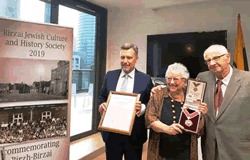
Glenda and Abel Levitt receiving the Medal of Honour from Lithuanian Ambassador to Israel Edminas Bagdonas.
Origins of the project
It was the Levitts’ involvement in the establishment of a Tolerance Education Centre in a high school in Plunge that first brought them to Birzai. They were invited there by Ingrida Vilkiene, Project Director of the International Commission for the Evaluation of the Crimes of the Nazi and Soviet regimes, to meet history teachers at the local high school, Vidmantas Jukonis and his son, Merunas, who had a great interest in the history of the Jews who had once resided in their town. However, the idea of creating a memorial bearing the names of the victims at the Birzai massacre site was born after the Levitts visited their old friend Benny Rabinowitz, lawyer, businessman, and philanthropist, in Cape Town in 2014. They approached Ben for help in sponsoring a talented young Lithuanian student whom they had undertaken to assist in studying law in Israel. Ben unhesitatingly agreed. When they then asked if he would help with their ongoing projects in Plunge, he said that he would rather do something for his own ancestral shtetl of Birzh, the birthplace of his grandfather, Faivl (Philip) Rabinowitz.
In early 2015, Ben approached me to become the local coordinator of the project. My first task was to compile a list of Birzh descendants in South Africa, starting with my own large family, which includes four main branches – Klitzner, Rabie, Bloom and Orelowitz. Among the descendants I found the name of Joseph Rabie, son of Monty and Ada. By strange coincidence, he had visited Birzai for the first time only a month after my own visit in August 2013. Joe, an urbanist living in Paris, studied architecture at the Technion in Haifa. We had both submitted articles describing our respective visits to Jewish Affairs, which later appeared in the same issue of the journal in 2014.[i]
The next step was a cocktail party of descendants at the Jewish Community Centre in Hatfield Street, Cape Town, on 30 July 2015. Some 44 guests attended. A committee, consisting of the Levitts, Benny Rabinowitz, Cyril Ferber and myself was formed to discuss fund raising, a design for a memorial, soliciting photos and letters from Birzh descendants for the museum and the establishment of a Tolerance Education Centre at a Birzai high school.
Glenda approached Joe to submit a design for the memorial, which he enthusiastically undertook to do. At the end of February 2016, he submitted a design that took the form of a suspended walkway above which was a ribbon of metal sheets on which the names of the victims would be inscribed. However, when he visited Birzai to inspect the site and meet the local architects, he was forced to modify his design. He reported:
The terrain is more complex than I had envisaged… The ground is not flat at all - there is a gully about 1.5 meters deep running through the central part, and the ground slopes down towards it, below the road level… Also, the vegetation is luscious, an intense dark green, this being high summer… What this means is that in order to maintain the ribbon as a horizontal band, it will be necessary to construct a light footbridge with a metal structure and a light handrail, winding through the forest and going over the gulley, at the same level as the road. Thus the ribbon will appear to float amongst the trees inside the forest, seeming to be detached from the ground as the bottom is not easily visible, a ribbon that is bright and shiny, to commemorate life, and pay tribute to what lies below. This effect will be reinforced as one walks along the ribbon, elevated above ground level and close to the names receding in perspective. … If we decide to cut out the names, the greenery and shadows of the ever-moving forest would be seen to shimmer through the lettering, and the effect would be soothing and reflexive…[ii]
At a meeting in Birzai attended by Abel and Glenda, Vidmantas and Merunas Jukonis, Birzai Mayor Irute Varziene (who had originally invited Abel and Glenda to undertake the project), the town architect and other municipality representatives, Joe’s design was unanimously approved. In November 2015, the Levitts arranged to have a geophysical map drawn up of the site of the mass graves. Prices were obtained for the creation of a monument, including construction, inscription and landscaping In February 2016, a list of the names of some 1700 of the 2400 victims of Birzai was obtained from Yad Vashem in Jerusalem.
When the Levitts visited Cape Town in June 2016, the project was officially named “The Birzai (Birzh) Memorial Project.” Its objectives were to erect a memorial at the site of the massacre in Pakamponys; to create a permanent exhibition of Jewish life in the town in the Birzai Museum; to support the Tolerance Education Centre at the Saules Gymnasium; to commission the writing of a book describing the contribution made by immigrants from Birzai (and surrounding towns) to the Jewish world, South Africa, the US, UK, Canada and elsewhere; to commission the translation into English of the Russian book, Jews on the Map of Lithuania: the Case of Birzai; to encourage Jews around the world to enrich the memory of their ancestral shtetls and to hold a ceremony at which the Memorial would be unveiled. A target of 200 000 Euros was set. The projected unveiling of the monument was 8 August 2017, the anniversary of the mass murder.
Already at this early stage an idea was conceived of a tour to Birzai to coincide with the dedication of the memorial. A bus-load (about 40-45 people) was envisaged. The Levitts secured an experienced guide, Regina Kopelovich in 2016. There were ongoing challenges finding enough accommodation for all the prospective participants. The Levitts, together with Merunas, visited every option of possible places where about 50 plus people could stay within the area of Birzai. About 13 km away was the Sodeliskis Manor House, which had seven rooms and catering facilities, as well as a venue for a Shabbat service and Friday night dinner. An advantage for some group members was that it had an elevator, the only one in Birzai. There was also a rented house within walking distance which could be used by our member Louis Zetler, who would be conducting the Friday evening Shabbat service.
In Planning…
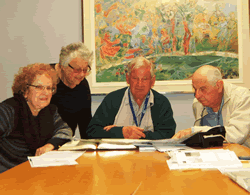
Veronica Belling (left), with Glenda Levitt, Ben Rabinowitz and Abel Levitt
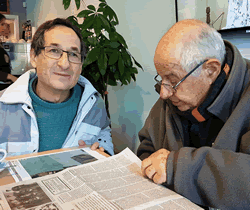
Joe Rabie and Abel Levitt, in Lithuania, 2016
Problem of the location of the memorial
All seemed to be progressing smoothly when Iruta Varziene was informed that Joe’s plan was situated on privately owned land. The municipality arranged a meeting between the owner, an elderly lady, her two children and Abel at the site, but it was clear that the owner was not ready to give up her rights for a narrow strip of her land required for the monument. It seemed a logical solution that the design be amended and the monument built on public land on the opposite side of the road. Although the vegetation there was not as dense, the metal ribbon would cross a body of water, historically a symbol of the passage from life to death.
In February 2017 Abel and Joe appealed to the Israeli ambassador, Amir Maimon, for the new design to be dealt with expeditiously so that the monument could be inaugurated as planned that same year. They pointed out that many of those who would be attending were aged and a year’s delay would seriously affect their ability to participate. Unfortunately, there were problems concerning the new site that caused considerable bureaucratic delays. Only on 28 March 2018 was approval for the Birzai/Birzh Memorial Project finally received.
Throughout 2018, Joe continued to work with Edgaras Mendelevich and his company, Senamiescio, in Vilnius, refining the project, drawing up the technical documents and tendering for the building company. They chose Judantys Projektai, which specialised in metal construction. The problem of the land was not solved. The municipality and other local and state institutions still had to approve the building permit. Problems were also faced regarding permission by the National Forestry Department to build on forestry land. This took a long time to come through. There were other bureaucratic obstacles to overcome, and final permission was granted only in February 2019.
Victim’s names on the memorial
Along with the land problem, a new difficulty had surfaced - that of the names on the memorial. Professor Jonathan Dorfan, a former South African physicist living in Palo Alto, California, realised that the final list of 1700 names that had been obtained from Yad Vashem in Jerusalem was for Birzai the district rather than for Birzai the town. In fact, the town with the most names on the list was Pasvalys, with others from Vabalninkas, Joniskis, Vaskai and Pumpenai. These victims were unlikely to have been murdered in Pakamponys. Thus the memorial, designed to record 1700 of the 2400 victims, was now left with a little over 400 names! What was to be done?
An option would have been to change the designation of the memorial to Birzai the District. However at a meeting in Israel of the Levitts together with Prof Dorfan and Dr Carol Hoffman, President of LitvakSIG, on 27 April 2018, this idea was rejected. It was decided instead to make a last ditch effort to collect more names of victims for Birzai the town, and to intersperse these on the memorial with Stars of David to represent the unknown victims, with larger stars for adults and smaller ones for children. Prof Dorfan performed miracles and a final total of 522 names were obtained.
On 12 November, the Birzai Jewish Culture and Historical Society was formed. It included both our representatives and Birzai community members, who would play an active part in organizing a program of activities during our four day visit. Around this time an executive committee was formed endorsed by Ben Rabinowitz. The members were Mannie Olswang Israel, responsible for controlling the finance, Jonathan Dorfan, Abel and Glenda Levitt, and Joe Rabie. The group worked in close consultation about the construction of the monument with Joe, Merunas Jukonis and Edgar Mendelevich, with skype calls of progress reports, problems and discussions once a week for many months.
On 25 November, Abel visited Cape Town to assist Ben in fundraising. Within several days four donations were obtained matching Ben’s contribution and several other smaller donations were also received. By that time 48 people had subscribed to the tour, now scheduled for 10-16 June 2019. The date was chosen in anticipation of the Memorial being completed, the ground being sufficiently dry for commencement of construction after the winter snow and to fall in the last week of the end-of-year term to enable participation of school children.
The Tour
The group was made up of over fifty participants. Not everyone participated in the whole tour. Some only joined in Birzai, others just came for the weekend of the dedication, while several hired their own private transport so did not travel on the bus. By far the largest contingent came from Israel followed by the United States. Six each came from Cape Town and the UK, three from France, and one from Canada. The two largest family groups were that of the Dorfan/Olswang family and the Levitts. Although a few had no prior South African connection, by far the majority did, particularly to Cape Town. As Gail Loon-Lustig, a medical doctor from Israel formerly from Belville expressed it, “Besides the predominantly South African accent of those who found their places in the bus, it was as if…[we were] transported into a space where we naturally knew one another…”.
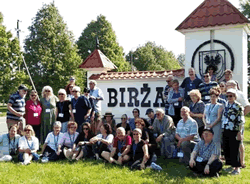
Also in the group was documentary maker Michael Kretzmar, a former South African living in the UK whose ancestors also came to South Africa from Birzai. A cousin of Danielle Lockwood (nee Kretzmar), the project’s UK representative, he came with a vision to make a documentary about the tour. The six Capetonians included Benny Rabinowitz (accompanied by his brother and sister-in-law from Israel, Jack and Esme Rabin), Cyril and Moira Ferber, Corinne Abel, Johnny Copelyn and myself.
The group constituted a microcosm of Eastern European Jewish history. Some, like Glenda Levitt, her children, Ari and Mia and grandchildren, Alon and Maya, Michael Bien, Cyril Ferber, the Dorfan and Olswang families, Danielle Lockwood, Michael and Mrs Kretzmar and their son, Sheryl and Lynn Silberg and Doris and Marshal Greenberg and their daughters, Rachel, Adena and Judith, Denyse Kirsch and her son Joel, Riva Friedman and her daughter Yael Daraby, David Israch, Linda Levy, Louis Zetler and Joe Rabie, had family members who were murdered at the site and whose names were on the memorial. Others like Benny Rabinowitz, Jack and Esme Rabin, Gillian Kay and I had grandparents or parents who were born in Birzai, and who left for South Africa in the late 19th and early 20th Centuries. Then there was Florence, daughter of a Birzai-born survivor of the Shavli ghetto, accompanied by her husband Dr Joseph Levine, son of a survivor from Raseiniai/Rasin. Joseph was born in prison in Raseiniai, where his mother was incarcerated before being exiled to Siberia. He spent his early childhood in the city of Syktyvkar, began his schooling in Lignitza, Poland, and immigrated to Israel when he was nine and a half years old! Today he and Florence live in New York. Another person with a direct connection to the Lithuanian massacres is Sylvie, Joe Rabie’s French wife whose grandfather had been in one of the convoys of French Jews transported from the internment camp in Drancy in Greater Paris to the Ninth Fort in Kaunas, where they were murdered.
The tour began in Vilnius at the Artis Centrum Hotel on the evening of 10 June. At the opening dinner Abel Levitt welcomed the group, commenting that it was the biggest Jewish tour to visit Birzai since the tragedy. Following dinner the group was addressed by a gentile descendant of a Birzai family, Professor Jurate Baranova, who recounted her mother’s memories of the day of the massacre - the shootings, the horror and the fear, believing that it would be their turn next, how she had not been able to eat for weeks afterwards. She recalled the day that the Jews’ clothes were brought back from the forest to the town square and distributed to people who stuffed them in their sacks and took them away. The family had a Jewish doctor, Dr Levine, who had once saved Jurate’s mother’s life. He was the first to be shot, in the street after leaving the house to deal with a reported medical emergency. He was used as an example because he was a prominent Jewish figure. Dr Levine was a relative of Jonathan and Mannie Dorfan and Mannie Olswang. His murder took place three weeks before the Pakamponys forest massacre.
On Tuesday there was a guided coach tour of Vilnius. The bus passed the old Jewish grave stones piled up by the river behind a metal fence accompanied by a memorial. There is a continuing debate about what to do with them. We visited the Museum of Tolerance and saw an exhibition of paintings by Samuel Bak. This building, once Vilnius’ Jewish Theatre, has been beautifully restored with a substantial donation from UNESCO. We then visited the very modest Green House Holocaust Museum, which records with unflinching reality the horror of what happened to the Jews of Lithuania. A very moving experience. We saw in the garden of the museum the powerful sculpture in honour of the Japanese vice-consul Chiune Sugihara, who against the orders of his government issued transit visas to between 2000 and 3500 Polish Jews who had taken refuge in Lithuania. This was followed by a visit to the surviving Jewish cemetery in Snipishok. We then went to the Ponar forest where 100 000, 70 000 of them Jews, were murdered - the largest number in one site in Lithuania. On our return we were taken on a tour of the old Vilna ghetto.
The following morning the group left for Birzai. We stopped in Kedainiai to have lunch, after which we were addressed by Rimantas Zirgulis, Director of the Museum of Diversity located in a beautifully restored building which was once a synagogue. Today the downstairs serves the local Kedainiai community as a theatre, art exhibition venue and for concert performances. The upstairs, once the women’s section, is a museum to the Jews of Kedainiai. The second restored synagogue is used as an Art centre. These two buildings are in the town centre near a very impressive memorial constructed in the shape of a giant triangle filled with symbolism honouring the murdered Jews of Kedainiai. Unfortunately we did not have time to visit the old Jewish cemetery which has some unusual and interesting tombstone designs.
From there we made our way to Kaunas, capital of independent Lithuania between the two World Wars (1919-1938). We drove through the old Jewish ghetto area of Slobodka (Vilijampolis in Lithuanian) and then proceeded to the city where our guide Regina pointed out the names of roads of Jewish interest, such as that of Mapu, the Hebrew novelist of the Haskalah period, who lived in Kaunas. We then stopped at the Seventh Fort, a fortification used as a Jewish concentration camp during the Second World War and where up to 5000 were murdered between 30 June and its closure on 10 August 1941.[i] The fort contains an exhibit on the Jews who were incarcerated there.
Thus we made our way to Birzai, where we were dropped at our respective hotels or lodgings. Our first evening was spent together at the Sodeliskis Manor house with a welcome dinner and an address by Jonathan Dorfan. The next morning we met at the park in the centre of Birzai adjacent to the old market, where we were addressed by a Lithuanian historian on the Jewish history of Birzai. Thereafter we went on a walking tour of the former Jewish quarter. Not much remains of Jewish Birzai, other than a former aged home on which very faint Hebrew letters spelling “Moshav Zekenim” are visible, and a couple of former synagogues so rebuilt as to be unrecognisable.
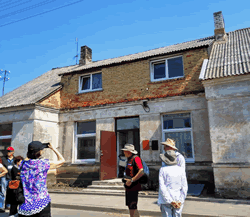
Former Jewish aged home in the old Jewish quarter.
A unique feature of the tour was the interaction with local inhabitants that preceded the unveiling. The first event was hosted by the Birzai Museum Sela located in the old Castle. Emilija Raibuzyte–Kalniniene and Edita Lansbergiene arranged for classes from five schools from surrounding villages to participate in talks by five members of our group. Glenda approached five tour participants whom she thought would be able to present subjects of interest to the students, and each addressed one of the visiting groups. We offered a wide and diverse range of subjects. As Lithuanian students are generally extremely shy and do not display emotions, for us as speakers it was difficult to gauge their reactions. It was explained that it is very typical Lithuanian cultural behaviour and not reflective of a lack of interest.
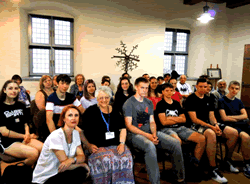
Glenda Levitt with Lithuanian student group at the Castle
A conference on the history of Birzai Jewry organised by Edita and Emilija of the Birzai Museum Sela was held after lunch. It included presentations by two Lithuanian doctoral candidates whose theses dealt with the history of the Jews of Lithuania. Julijana Leganovic spoke on “Jews in Interwar Lithuania: Between Cognition, Love to Lithuania and Antisemitism” while Ruta Anulyta spoke about Jewish death records. From our group, Yael Daraby spoke on Jewish laws, customs and traditions, while I spoke about our Litvak heritage. This was followed by the opening of an exhibition of the artist Esther Lurie, a survivor of the Kovno Ghetto and a renowned Holocaust artist. Her sketches are not only well drawn but constitute an accurate and poignant record of life in the ghetto. It was introduced by Assia Gutterman a Jewish woman from Kaunas. She was accompanied by Moshe Beirak, leader of the Kaunas Jewish community and Gabay of the Kaunas Choral Synagogue. At the evening meal held at the Castle restaurant, participants were invited by Michael Bien to share their connections to Birzai and exchange stories. The evening was a great success.
On Friday morning, we visited the old Jewish and Karaite cemetery where we were addressed by Merunas and Vidmantas Jukonis. Vidmantas, who had discovered the Jewish cemetery as a young boy swimming in the lake, spoke with passion and dedication of the role he has undertaken to preserve the memory of the Jews of his town. Between 2011 and 2013, with students from the local high school, they had set about clearing the cemetery. In this they were assisted by a Lutheran congregation from Germany, and between 2013 and 2014 they partnered with the Russian Jewish Research and Teaching Center ‘Sefer’ to decipher the names on the cemetery’s 1600 tombstones. The list of names is included in the book, Jews on the Map of Lithuania: the Case of Birzai, published in 2014. This enabled some of our group to find their ancestors tombstones and to say kaddish, a very moving experience.
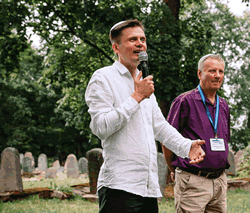
Merunas Jukonis and father Vidmantas at the Jewish cemetery
We then continued to the Birzu ‘Saules’ Gimnazija, whose principal Dainius Korsakas spoke on the history of the school, and about their attempt to identify Jewish students killed in the Holocaust. Out of the 200 students who graduated in 1941, they had identified fifty who were possibly Jewish. This was followed by the history of their Tolerance Education Centre presented by two of the students. It was started in 2015 when they began visiting a social service centre where they interacted with children with disabilities. Their then history teacher, Vidmantas Jukonis, introduced the subject of “Our Neighbour Jew.”
After the lectures, we were entertained with Lithuanian folk dancing and songs by the school’s outstanding prizewinning choir, accompanied by folk instruments. The dancing of the young boys in particular was reminiscent of Israeli dancing that we learned in the Habonim movement. We were appreciative and touched by the enormous effort that was put into the performances on our behalf by the students and the organization, direction and training by the teachers involved in the production.
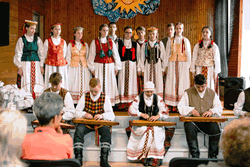
Thereafter eleven of our group spoke to senior classes of students sufficiently conversant in English to understand us. In my group was a student who attributed her proficiency in English to watching cartoons on television! It was again difficult to gauge the reaction to our presentations, but the headmaster told Glenda how delighted he was with the very positive feedback he had received from them.
In the evening we were transported to the Sodeliskiu manor estate where a Friday night service was conducted by former South African Israeli Louis Zetler. It was followed by a Sabbath dinner, attended by Lithuanian dignitaries and local Jewish guests including Israeli Ambassador Amir Maimon, the mayor of Birzai, Vytas Jareckas, the representative of the Siauliai Jewish community Sania Kerbelis, people involved with the project over the past four years and representatives of the high school student body. Writes Glenda:
The Friday evening was of momentous importance. We were participating in a communal Shabbat service that had not taken place in Birzai/Birzh since the Soviet occupation in 1940. We shared this with about 50 local guests, allowing them to enter the world of the spirituality of Jews and our connection to our Sabbath. The meal was purposely as traditional as possible, including gefilte fish and chicken soup, and the candle lighting ceremony with all our women participants lighting in unison, covered in headscarves and chanting the prayer together, was a moment of great beauty, spirituality and sadness. The white cloth over the long table, the table covered with the flickering of so many candles reflecting in the large glass windows captured our purpose for being in that town, in that place, at that moment in time, remembering a world that was no more, but that we were there.
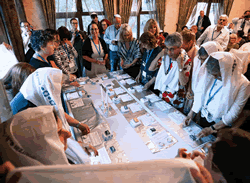
On Saturday, non-Sabbath observers had the option of a bus tour to Rakiskis (Rakishok), Kamajai (Kamai) and Kupiskis (Kupishok). In Rakiskis we stopped to explore the road where the Jews once lived and where the synagogue had been located and visited the cemetery to see the marble memorial and new fence with Stars of David, constructed in late 2013. From Rakiskis we drove through Kamajai, the tiny maternal ancestral shtetl of Benny Rabinowitz. We made our way to the larger city of Kupiskis, where the former synagogue building today housing the public library was being renovated. Finally, we returned to Birzai via Panevezys, the third largest city in Lithuania, where the famous Ponevezh Yeshiva building has been converted into a bakery and coffee shop.
A special feature of the Saturday evening dinner at the Alaus Kelias restaurant was the gift to every participant of a small jar of honey made by Vidmantas accompanied by a message of Biblical quotes referring to honey and its symbolism to our journey in Birzai.
The dedication ceremony began at midday on Sunday in a clearing on Zemaites Street, where a tree planting ceremony was held to honour the families of “Savers of the Jews” who hid and protected the Jews at the risk of their own lives. Guests included Mayor Jareckas and the ambassadors of Japan, China and Israel. All participants were given yellow stars to wear in solidarity with the murdered Jews. Glenda Levitt as well as representatives from the families of the Savers addressed the crowd. Writes Glenda:
The ceremony took place at the site of what had been the Jewish Ghetto where the Jews were forced to congregate before being taken to the Pakamponys forest to be shot. Today it is a clearing near the building that was a Mikveh and is being restored into a small hotel. This tree planting ceremony to honour those Lithuanians who saved Jews is so far only the second time that this acknowledgement is taking place at an outdoor venue. The first was erected in 2006 at the mass graves in the forest of Kausenai near Plunge at the initiation of Abel and me. The proposal was enthusiastically accepted by the two ladies of the museum, Edita and Emilija, who devoted much time to researching for information and together with the municipality and gardening department under the continued care of Merunas, arranged a beautiful meaningful ceremony that was deeply appreciated not only by the descendants of the Savers but of the local community.
From there, some 500 people walked the four kilometres to the site of the massacre, the same route that was followed by the Jews who were murdered there. The school children dressed in national Lithuanian dress carried pots of yellow flowers which would be used to create a Magen David at the site of the massacre.
The idea of creating a Magen David out of yellow flowers to be placed on the mass grave by school children was put forward by Glenda to Edita and Emilija and municipality representative Irute. They again responded with great enthusiasm. The flowers were carried from the site of the tree planting ceremony by children walking the three miles along the route that the Jews were marched to the forest in Pakamponys where they were murdered. Upon arrival they children placed the little pots of bright yellow flowers pre-marked into the shape of a large Magen David.
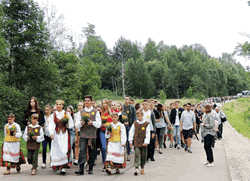
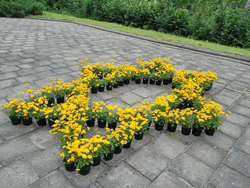
The ceremony was very moving. There were inspiring addresses by Ambassador Maimon, Merunas Jukonis, the extraordinary young man without whom this whole Birzai event could not have happened, Jewish member of the Lithuanian parliament, Immanuel Zingaris, Abel Levitt and Jonathan Dorfan. The shofar was blown and the Birzu ‘Saules’ Gimnazija choir sang two Israeli songs, Lu Yehi (Let it be) and the Kabbalistic prayer Ana be-kho’ah with aplomb. Louis Zetler concluded the ceremony with the kaddish. The Jewish community was represented by Gennady Kofman chairman of the Panevezys Jewish community.
The unveiling of the memorial was of course the high point. All those who had family who had been murdered were called up to unveil the eleven sheets of metal of the memorial with names. This included the descendants of the last Jew of Birzai, Leta Vainoriene, daughter of Sheftl Melamed, and her family, and Birzai-born Sonia Segal from Israel. The list was carefully constructed and divided so that all could participate. The honour of unveiling the first tablet went to Ben Rabinowitz, the second to Corinne Abel and Johnny Copelyn and the third to Joe Rabie, architect of this remarkable and unique memorial, and his wife Sylvie and daughter Eleonora. The whole ceremony was recorded on Lithuanian national television.
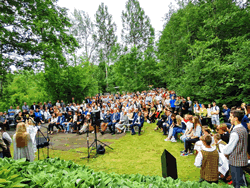
Crowd in the Pakamponys forest
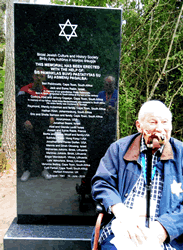
Ben Rabinowitz by tablet listing the donors
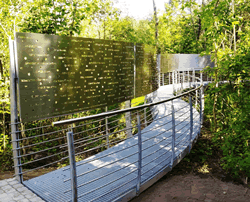
Memorial to the 2400 Jewish victims of Birzai, Pakamponys forest.
The whole vision of the Birzai journey - the connecting with our Birzai heritage and with the municipality and locals, working with the ladies of the museum, involving students, working with the headmaster, the Friday evening, the ceremony of the Savers and the ceremony at the forest - was that of Glenda and Abel Levitt. This of course could only have taken place with the roles played by Ben Rabinowitz, Joe Rabie, Merunas and Vidmantas Jukonis and all the others who gave unstinting support. Also moving for me was meeting Jewish Lithuanians, the children of Holocaust survivors born after the war who had never left and with whom I was able to communicate in an authentic Litvish Yiddish. For the first time I felt a strange sense of identification with the city of my grandparents and feel that I left a small corner of my heart over there among the forests and the lakes.
[1] Veronica Belling, “Lithuania: a very personal journey.” Jewish Affairs, 69, 1, (Passover, 2014): 10-17: Joe Rabie, “Landscapes of my fathers.” Jewish Affairs 69, 1, (Passover, 2014): 18-25.
[2] Birzai Report, E-mail Joseph Rabie 1 Jul 2016
[3] Seventh Fort, Wikipedia, https://en.wikipedia.org/wiki/Seventh_Fort#World_War_II
https://www.sajbd.org/media/the-birzai-birzh-memorial-project-lithuania |